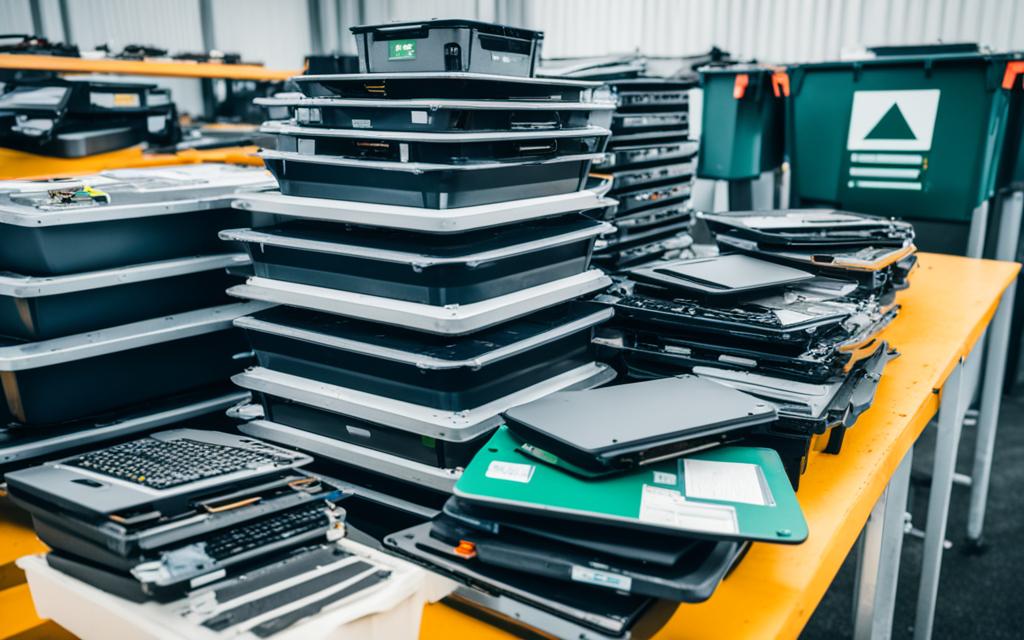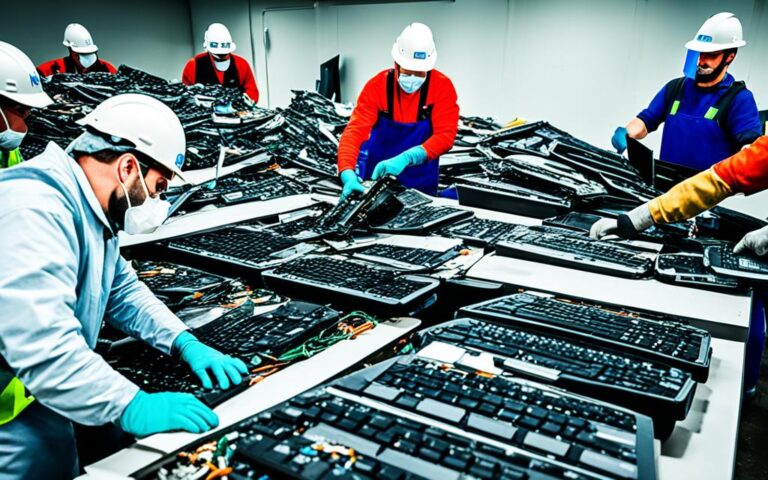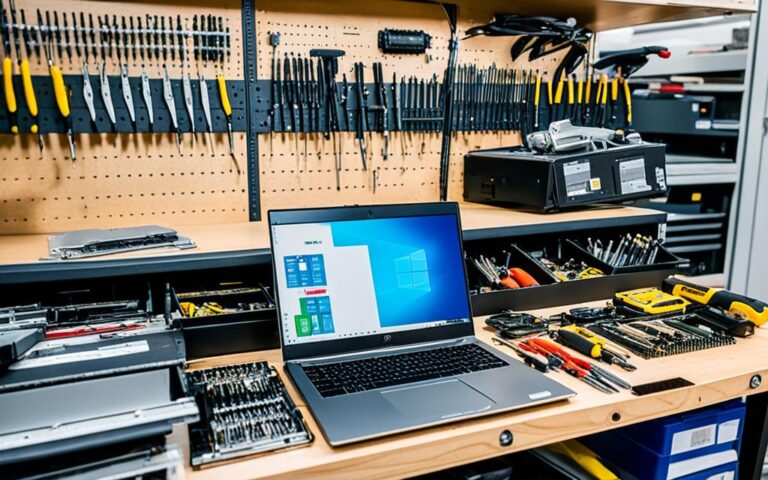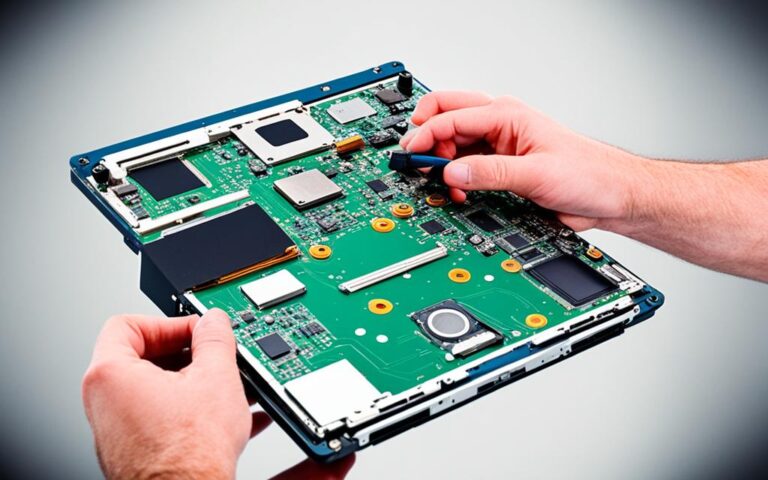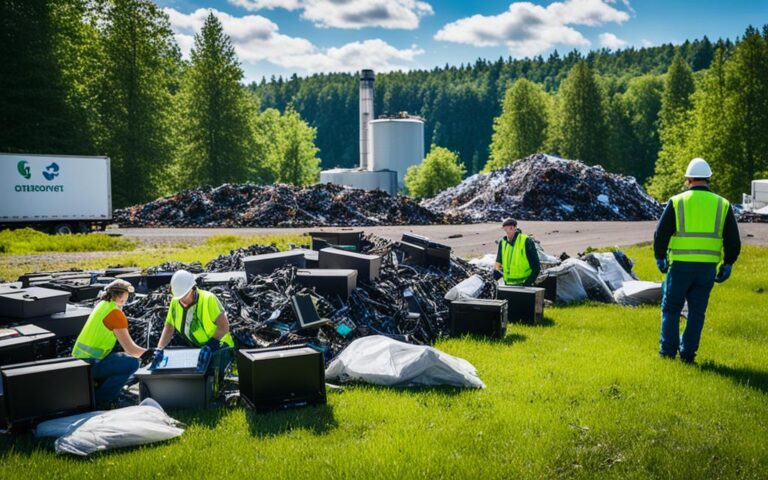How Laptop Recycling Contributes to Energy Efficiency
Laptop recycling plays a crucial role in promoting energy efficiency and reducing the carbon footprint in the United Kingdom. By recycling laptops, we can conserve valuable resources and minimize the environmental impact of electronic waste. In this article, we will explore the concept of green computing and the need for energy-efficient practices in the IT industry. We will also delve into the top strategies for implementing green computing, including laptop recycling programs, to ensure a greener and more sustainable future.
What is Green Computing?
Green computing, also known as ICT sustainability or sustainable computing, involves adopting environmentally friendly practices in the manufacturing, design, disposal, and use of hardware, software, and related services. The goal of green computing is to reduce the environmental impact of IT systems and operations, including electronic waste production and energy consumption. It focuses on practices that promote energy efficiency and sustainability in the IT industry.
Environmentally Friendly Practices
Green computing encompasses a range of environmentally friendly practices. This includes implementing energy-efficient hardware and software solutions, optimizing data centers for reduced energy consumption, adopting virtualization and cloud computing technologies, and employing strategies to minimize electronic waste and promote responsible hardware disposal.
Furthermore, green computing encourages the use of energy-saving techniques such as power management, server consolidation, and the recycling of waste heat generated by IT equipment. By implementing these practices, businesses and organizations can significantly reduce their energy consumption and carbon footprint.
The Importance of Green Computing in ICT Sustainability
Green computing is a vital aspect of ICT sustainability. As technology becomes increasingly integral to our daily lives, the demand for energy and resources continues to rise. By adopting green computing practices, we can ensure that the growth of the IT industry is sustainable and environmentally responsible.
Green computing aims to strike a balance between meeting technology requirements and mitigating its environmental impact. It is about using technology in a way that conserves resources, minimizes waste, and reduces energy consumption.
With the rapid advancement of technology, the need for green computing has become more prominent than ever. By incorporating environmentally friendly practices into the design, production, and usage of hardware and software, we can work towards a more sustainable future.
Energy Consumption and Software Usage
Energy consumption is a significant consideration in green computing. By optimizing software usage and implementing energy-efficient algorithms, we can reduce the power requirements of computers and IT systems. This includes developing software that is designed to be resource-efficient, minimizing the processing power and energy needed to perform tasks.
Additionally, green computing encourages the adoption of software-based energy management systems that control and optimize energy usage in IT infrastructure.
Hardware Disposal and Electronic Waste Management
Proper hardware disposal is an essential part of green computing. As technology advances, older hardware becomes obsolete and needs to be replaced. It is crucial to dispose of obsolete hardware responsibly to prevent it from becoming electronic waste.
Green computing promotes the recycling and refurbishment of hardware whenever possible. This reduces the generation of electronic waste and extends the lifespan of IT equipment. Furthermore, responsible disposal practices ensure that hazardous materials present in electronic devices do not harm the environment.
Why do We Need Green Computing?
Despite their perceived cleanliness, computers significantly contribute to environmental pollution and carbon emissions. The ICT sector alone accounts for 1.8%–2.8% of global greenhouse gas emissions. Adopting green computing practices, such as energy-saving measures and recycling initiatives, can help reduce these emissions and minimize the generation of electronic waste. By optimizing energy usage and implementing energy-efficient practices, we can make a significant impact on reducing our carbon footprint.
Electronic waste, commonly known as e-waste, poses a significant environmental threat. The rapid advancement of technology has led to the accumulation of obsolete electronic devices. Improper disposal of e-waste not only leads to the release of harmful toxins into the environment but also contributes to the depletion of valuable natural resources. Recycling electronic waste is crucial for mitigating these detrimental effects.
Recycling plays a vital role in reducing electronic waste and conserving valuable resources. By responsibly recycling devices such as laptops, we can recover precious metals and other components that can be reused for manufacturing new products. This reduces the need for extracting and processing raw materials, effectively conserving energy and reducing carbon emissions.
The Environmental Impact of Computers
Computers, including laptops, have become indispensable in our modern lives. However, their production and usage have a significant environmental impact. The manufacturing process of electronic devices consumes large amounts of energy and resources, contributing to pollution and carbon emissions. Additionally, the improper disposal of electronic waste leads to leaching of toxic substances into soil and water bodies, posing a threat to ecosystems and human health.
Green computing aims to address these challenges by implementing energy-efficient practices throughout the lifecycle of electronic devices. This includes minimizing energy consumption during production, improving the energy efficiency of devices, and promoting responsible recycling and waste management.
Here is a table illustrating the environmental impact of computers:
| Environmental Impact | Description |
|---|---|
| Environmental Pollution | Computers contribute to air and water pollution through the release of greenhouse gases and toxic substances during manufacturing and disposal. |
| Carbon Emissions | The energy-intensive manufacturing process of computers results in significant carbon emissions, contributing to climate change. |
| Electronic Waste | Obsolete computers and electronic devices contribute to the growing problem of electronic waste, which requires proper disposal to prevent environmental contamination. |
| Energy-efficient Practices | Implementing energy-saving measures and adopting energy-efficient technologies can help reduce the environmental impact of computers. |
| Recycling | Proper recycling of electronic devices helps minimize e-waste and promotes resource conservation. |
Source: Own elaboration.
By embracing green computing practices, individuals, businesses, and organizations can contribute to environmental sustainability and reduce their carbon footprint. Energy-efficient practices, such as power management and adopting renewable energy sources, can significantly reduce the energy consumption of computers. Additionally, responsible recycling ensures that valuable resources are reclaimed and reused, decreasing the need for environmentally harmful mining and manufacturing processes.
Adopting green computing not only benefits the environment but also provides cost savings through reduced energy consumption and improved resource management. By making conscious choices in the design, production, usage, and disposal of computers, we can pave the way towards a greener and more sustainable future.
Top 12 Strategies for Implementing Green Computing in the IT Industry
Businesses and organizations can play a significant role in promoting green computing in the IT industry by implementing various strategies. These strategies focus on energy efficiency, waste reduction, and the adoption of sustainable practices. By incorporating these strategies, businesses can not only contribute to a greener and more sustainable future but also enjoy long-term cost savings.
-
Proper Electronic Waste Disposal
Responsible electronic waste disposal is essential for minimizing environmental impact. Establishing partnerships with certified e-waste recyclers ensures that outdated or defective electronic equipment is disposed of safely and ethically. It helps reduce landfill waste and allows for the recovery of valuable resources through recycling and refurbishment.
-
Energy-Efficient Computer Selection
Choosing energy-efficient computers is crucial for reducing energy consumption. Opting for laptops instead of desktop computers can result in significant energy savings, as laptops typically require less power. Additionally, selecting computers with ENERGY STAR certification ensures that they meet strict energy efficiency criteria.
-
Energy-Efficient Display Selection
Energy-efficient display selection is another important consideration. LCD monitors, for example, consume less energy compared to traditional CRT monitors. LED-backlit displays are even more energy-efficient and provide better image quality. Selecting displays with energy-saving features such as automatic power-off or brightness adjustment can further enhance energy efficiency.
-
Strategic Power Management
Implementing power management strategies can significantly reduce energy consumption. Enabling sleep or hibernation modes on computers when not in use, setting up power-saving profiles, and adjusting display sleep settings are simple yet effective ways to conserve energy. These measures help minimize idle power consumption and contribute to overall energy efficiency.
-
Utilizing Alternative Energy Sources
Transitioning to alternative energy sources such as solar or wind power can help businesses reduce their carbon footprint. Installing renewable energy systems or purchasing green energy from certified suppliers can provide sustainable and clean power for IT operations. By harnessing alternative energy, businesses can minimize reliance on fossil fuels and promote a greener computing environment.
-
Deploying Virtual Technologies
Virtualization technologies enable businesses to consolidate multiple physical servers into virtual ones, reducing the need for extensive hardware infrastructure. By maximizing server utilization, businesses can save energy, reduce electronic waste, and streamline IT operations. Virtualization also offers scalability and flexibility, allowing for efficient resource allocation and easily adapting to changing business needs.
-
Educating Employees on Energy Efficiency
Employee awareness and engagement are critical in promoting energy efficiency. Educating employees on best practices, such as turning off equipment when not in use, reducing paper waste through digital workflows, and using power-saving features, encourages responsible energy consumption. By fostering a culture of sustainability, businesses can achieve significant energy savings collectively.
-
Implementing Power Management Technology
Utilizing advanced power management technologies can automate energy-saving measures. Automated systems can monitor and control power consumption across IT infrastructure, optimizing energy usage without compromising performance. These technologies can identify idle or underutilized resources and put them into low-power states, resulting in energy savings without impacting productivity.
-
Encouraging Remote Working
Promoting remote working not only provides employees with flexibility but also reduces energy consumption. By allowing employees to work from home or telecommute, businesses can minimize the need for office space and the associated energy consumption. Remote working also cuts down on commuting emissions, further contributing to environmental sustainability.
-
Participating in Electronic Recycling Programs
Participating in electronic recycling programs ensures responsible disposal of end-of-life electronic equipment. Many manufacturers and organizations operate recycling initiatives that allow businesses to safely dispose of outdated or non-functional devices. By recycling electronics, valuable resources can be recovered, reducing the demand for raw materials and minimizing electronic waste.
-
Optimizing Data Center Efficiency
Data centers consume a significant amount of energy, and optimizing their efficiency is crucial for green computing. Strategies such as improving cooling techniques, using energy-efficient server hardware, and employing virtualization technologies in data centers can result in substantial energy savings. By prioritizing data center efficiency, businesses can minimize energy waste and achieve higher sustainability.
-
Considering Power Usage Effectiveness (PUE)
Power Usage Effectiveness (PUE) is a metric that measures the energy efficiency of data centers. Lower PUE values indicate better energy utilization, whereas higher values imply higher energy wastage. By monitoring and striving for a low PUE, businesses can ensure that their data centers are operating optimally and achieving maximum energy efficiency.
“Implementing these strategies not only contributes to energy efficiency but also aligns businesses with sustainable practices that support environmental conservation and resource preservation.”
Energy Efficiency Benefits of Laptops
Laptops offer significant energy efficiency advantages over desktop computers, making them an ideal choice for environmentally conscious individuals and organizations. The design and features of laptops contribute to reduced energy expenditure, powering a more sustainable and energy-efficient computing experience.
Compared to desktop computers, laptops have lower power supply units (PSUs) and consume less energy. While ordinary desktop computers can consume up to 175 watts at their peak, laptops typically only require up to 60 watts. This substantial difference in power consumption leads to significant energy conservation and cost savings over time.
Moreover, laptops that rely on AC adapters instead of battery power are even more energy-efficient. By plugging the laptop directly into a power source, the device uses a minimal amount of energy from the battery, resulting in extended battery life and reduced energy consumption overall.
Implementing energy-efficient practices, such as using laptops and optimizing power usage, aligns with green computing principles. By adopting laptops and other green computing practices, businesses and individuals can achieve energy savings of up to 50%. This reduction in energy expenditure not only leads to cost savings but also contributes to a smaller carbon footprint, promoting a more sustainable future.
Furthermore, using energy-efficient laptops is just one aspect of implementing green computing practices. Taking a holistic approach to energy conservation involves utilizing power management features, selecting energy-efficient displays, and considering other sustainable computing strategies. By incorporating these practices, the cumulative impact on energy efficiency can be substantial.
Energy-efficient laptops are not only beneficial for reducing individual energy consumption but also for organizations striving for sustainability. These laptops can be particularly advantageous in industries where portability and low energy consumption are paramount, such as in remote work environments, educational institutions, and businesses with a high emphasis on energy conservation.
Energy Efficiency Comparison: Laptops vs. Desktop Computers
| Type of Computer | Power Consumption (Watts) |
|---|---|
| Desktop Computer | Up to 175 |
| Laptop | Up to 60 |
The Role of Recycling in Energy Efficiency
Recycling electronic waste is a vital aspect of promoting energy efficiency and environmental sustainability. Through proper recycling practices, such as refurbishment and participation in recycling programs, businesses and individuals can contribute to a greener and more sustainable future.
Reducing E-Waste Through Refurbishment
One effective way to promote energy efficiency and resource conservation is through the refurbishment of electronic devices. Refurbishing electronics involves repairing, upgrading, and restoring them to their full functionality. This process not only extends the lifespan of these devices but also reduces the need for new electronic products to be manufactured, thus minimizing the carbon footprint associated with their production.
Participating in Recycling Programs
Another important aspect of electronic waste recycling is participation in recycling programs. These programs provide designated drop-off points or collection services for electronic devices, ensuring that they are properly recycled and their valuable materials are recovered. By responsibly disposing of old or unwanted electronics through these programs, businesses and individuals can prevent them from ending up in landfills and polluting the environment.
By adopting energy-efficient practices alongside responsible electronic waste management, businesses and individuals can contribute significantly to environmental sustainability. This includes reducing energy consumption, minimizing e-waste generation, and conserving valuable resources.
Benefits of Electronic Waste Recycling
| Benefits | Description |
|---|---|
| Resource Conservation | By recycling electronic waste, valuable resources such as precious metals and rare earth elements can be recovered and reused in the production of new devices. |
| Energy Savings | Recycling electronic waste requires less energy compared to the extraction and refining of raw materials. This helps in reducing overall energy consumption. |
| Reduced Environmental Impact | Proper recycling of electronic waste minimizes the release of toxic substances, such as lead, mercury, and cadmium, into the environment. |
| Job Creation | Electronic waste recycling programs create employment opportunities in the collection, sorting, refurbishment, and recycling of electronic devices. |
| Compliance with Regulations | Recycling electronic waste helps businesses and individuals comply with regulations and laws related to e-waste disposal, preventing legal and financial penalties. |
By understanding the role of recycling in energy efficiency and actively participating in electronic waste recycling initiatives, businesses and individuals can contribute to environmental sustainability while also reaping the benefits of resource conservation and energy savings.
The Potential of Green Computing for Energy Conservation
Green computing presents numerous opportunities for businesses to conserve energy and reduce their environmental impact. By adopting a range of eco-friendly practices, organizations can make significant strides towards energy efficiency and sustainability in the IT industry.
Power Management Technology
By leveraging power management technology, businesses can optimize energy usage and minimize waste. Power management features allow computers to enter low-power modes when not in use, reducing energy consumption without sacrificing productivity. Implementing power management technology can lead to substantial energy savings and a greener computing environment.
Limit Printing through Digital Workflows
Transitioning to digital workflows can significantly reduce printing needs and paper waste. By embracing digital documents, businesses can limit the use of resources such as ink and paper, while still maintaining efficient communication and collaboration. Encouraging employees to embrace digital alternatives and implementing effective document management systems can contribute to energy conservation and sustainability.
Recycling Electronics
Electronic recycling plays a vital role in green computing and energy conservation. By responsibly disposing of outdated or non-functioning electronics, businesses can recover valuable resources and reduce electronic waste. Implementing electronic recycling initiatives and partnering with reputable recycling organizations can ensure proper disposal and promote a circular economy, contributing to a more sustainable future.
Promoting Remote Working
The rise of remote working offers significant opportunities for energy conservation. By enabling employees to work from home or remotely, businesses can reduce energy consumption associated with office spaces, such as heating, cooling, and lighting. Remote working also reduces transportation-related carbon emissions, contributing to a more sustainable and environmentally friendly workforce.
Striving for Carbon-Neutral Computing
Carbon-neutral computing involves offsetting carbon emissions associated with IT operations through various means, such as renewable energy investments or carbon offset programs. By striving for carbon neutrality, businesses can actively contribute to mitigating their environmental impact and supporting the transition to a low-carbon future.
By embracing power management technology, limiting printing through digital workflows, recycling electronics, promoting remote working, and striving for carbon-neutral computing, businesses can make significant strides in energy efficiency and sustainability. Each of these initiatives contributes to a greener computing environment and supports a more sustainable future.
| Initiative | Benefits |
|---|---|
| Power Management Technology | – Optimize energy usage – Reduce waste – Cost savings |
| Limit Printing through Digital Workflows | – Reduce paper waste – Minimize ink and resource consumption – Efficient communication |
| Recycling Electronics | – Recover valuable resources – Minimize electronic waste – Promote circular economy |
| Promoting Remote Working | – Reduce energy consumption – Carbon emissions reduction – Increased work-life balance |
| Striving for Carbon-Neutral Computing | – Offset carbon emissions – Support renewable energy – Environmental stewardship |
Conclusion
Green computing is a crucial aspect of promoting energy efficiency and sustainability in the IT industry. By embracing initiatives such as electronic waste recycling, energy-efficient practices, and the implementation of green technologies, businesses can contribute to reducing their carbon footprint and conserving valuable resources.
Electronic waste, also known as e-waste, is a significant global environmental issue. Green computing recognizes the importance of responsibly managing e-waste through initiatives like recycling and refurbishment. By diverting e-waste from landfills and recovering valuable resources, we can minimize the environmental impact of electronic devices and promote a more sustainable future.
In addition to managing e-waste, energy efficiency is a key focus of green computing. Implementing energy-efficient practices, such as selecting energy-efficient computers and displays, utilizing power management technology, and utilizing alternative energy sources, can significantly reduce energy consumption and carbon emissions.
By embracing green computing, businesses can not only contribute to a greener and more sustainable world, but also benefit from cost savings and improved reputation. As the IT industry continues to expand, it becomes crucial to prioritize green computing practices to ensure a more environmentally conscious and resource-efficient future.
FAQ
How does laptop recycling contribute to energy efficiency?
Laptop recycling plays a crucial role in promoting energy efficiency by conserving valuable resources and minimizing the environmental impact of electronic waste.
What is green computing?
Green computing, also known as ICT sustainability or sustainable computing, involves adopting environmentally friendly practices in the manufacturing, design, disposal, and use of hardware, software, and related services.
Why do we need green computing?
Green computing is necessary to reduce environmental pollution, carbon emissions, and the generation of electronic waste. It focuses on energy-efficient practices and recycling initiatives to minimize the impact of IT systems and operations.
What are the top strategies for implementing green computing in the IT industry?
Businesses and organizations can implement strategies such as proper electronic waste disposal, selecting energy-efficient computers and displays, strategic power management, utilizing alternative energy sources, deploying virtual technologies, and introducing electronic recycling programs.
What are the energy efficiency benefits of laptops?
Laptops are more energy-efficient than desktop computers due to their lower power supply units (PSUs) and reduced energy consumption. By opting for laptops and implementing other green computing practices, energy savings of up to 50% can be achieved.
What is the role of recycling in energy efficiency?
Recycling electronic waste is essential for promoting energy efficiency and environmental sustainability. Proper recycling practices, such as refurbishment and participation in recycling programs, help reduce e-waste and recover valuable resources.
What is the potential of green computing for energy conservation?
Green computing offers various opportunities for energy conservation, including power management technology, limiting printing through digital workflows, recycling electronics, promoting remote working, and striving for carbon-neutral computing.
How does green computing contribute to energy efficiency and sustainability?
Green computing initiatives such as electronic waste recycling, energy-efficient practices, and the implementation of green technologies can help businesses reduce their carbon footprint, conserve resources, and create a more sustainable future.

